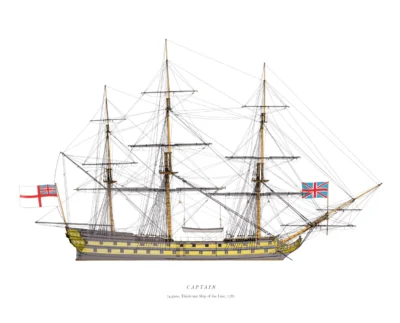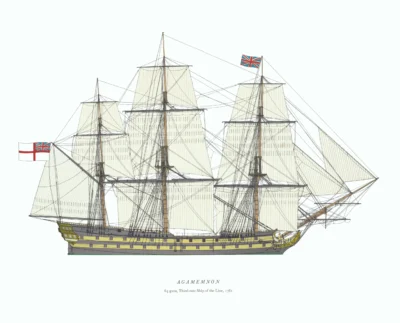H.M.S. Royal Sovereign, Battleship, 1892
£17.50
Royal Sovereign: lead ship of 7 pre-Dreadnought Royal Sovereign Class battleships (scroll down for a more detailed Description)
Published 1971 by © Hugh Evelyn Limited; drawn by Martin Holbrook
Size: c. 42.5 x 35.5 cm [17″ x 14″] (may vary slightly from printers’ cut 50 years ago)
Printed on high white matt cardstock 154 g/sm2
Print is LARGE size – shipping is the same for 1 to 10 prints (based on largest print size in your order) – see Shipping & Returns.
In stock
Description

Royal Sovereign:
Battleship;
Built: HM Dockyard Portsmouth
Ordered: Naval Defence Act 1889; Laid: 1889; Launched: 1891; Commissioned: 1892; Decommissioned: 1909;
14,380 Tons; Length: 380′ (116 m); Beam: 75′ (23 m); Draught: 28′ (8 m);
Power: 11,000 ihp (8,200 kW); 2 shafts; 17.5 knots (32.4 km/h; 20.1 mph);
Range: 720 nmi (8,740 km; 5,430 mi) @ 10 knots (19 km/h; 12 mph)
Armament: Guns: 2 x twin 13.5″ (343 mm); 10 x 6″ (152 mm); 10 x 6 lb (2.7 kg) and 12 x 3 lb (1.4 kg); 7 × 18 in (450 mm) torpedo tubes;
HMS Royal Sovereign was the lead ship of eight “pre-dreadnought” battleships built for the Royal Navy in the 1890s. They were the centrepiece of the Naval Defence Act, 1889 which allocated £21.5 million for a vast expansion programme when it was realised the Royal Navy had failed to match the pace and development of rival navies in France, Russia, Germany and the United States during the latter half of the 19th century. The Act also formalised the “two-power standard”, whereby the Royal Navy sought to be as large as the next two major naval powers combined. Preliminary work on the Royal Sovereign class began in 1888. Sir William White, was instructed to design an improved and enlarged version of the Trafalgar class. The Board of Admiralty agreed to a design that resembled an enlarged version of the earlier Admiral class. The Royal Sovereigns are often considered the first of the pre-dreadnoughts. When it was launched in 1906 HMS Dreadnought rendered all existing battleships obsolete. At 14,150 LT she was built in dry-dock at Portsmouth Royal Navy Dockyard (there was no slipway long enough). Her keel was laid in September 1889, she was launched in February 1891 and commissioned in 1892. She relieved HMS Camperdown as flagship of the Channel Fleet, a role she performed for the next five years. After taking part in Queen Victoria’s Diamond Spithead Review on 26th June 1897, she left for the Mediterranean, returning to Portsmouth in 1902. After a major refit the remainder of her career was mainly as a reserve vessel until she was sold in 1913 to be broken up, eventually in Genoa.
Additional information
| Weight | 0.0232 kg |
|---|---|
| Dimensions | 44 × 35.5 cm |





